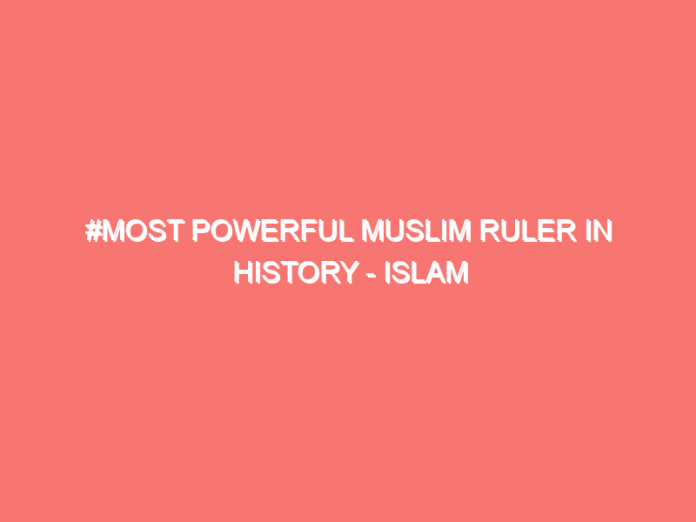Most Powerful Muslim Ruler In History
Introduction:
A Muslim ruler is a leader who governs a Muslim-majority population or a territory with a significant Muslim population. Muslim rulers have held power in various regions throughout history, including the Middle East, North Africa, Central Asia, and Southeast Asia. They have played an important role in shaping the political, social, and cultural landscape of these regions. Muslim rulers have come to power through various means, such as hereditary succession, military conquest, or political appointment. Many Muslim rulers have been known for their military prowess, political acumen, and religious devotion. They have also been known for their contributions to art, science, and architecture.
10 Best Muslim Rulers and Leaders Who Changed History:
Saladin:
Saladin (1137-1193) was a Muslim ruler who served as the first Sultan of Egypt and Syria and founded the Ayyubid dynasty. He is best known for recapturing Jerusalem from the crusaders during the Third Crusade in 1187, and for his chivalry and generosity towards his enemies. Saladin was born into a Kurdish family in what is now Iraq and began his career as a soldier and commander in the service of the Muslim ruler of Egypt. He quickly rose through the ranks, eventually taking control of Egypt and expanding his territories through military conquests.
Saladin was known for his military prowess, political acumen, and religious devotion. He was also known for his chivalry, as well as his generous treatment of prisoners of war and civilians. He was respected by his enemies as well as by his fellow Muslim leaders. Saladin’s victory in the Battle of Hattin and the subsequent recapture of Jerusalem was a significant turning point in the history of the crusades and solidified his reputation as one of the greatest military leaders of the medieval period.
Sultan Mehmet II:
Sultan Mehmet II, also known as Mehmet the Conqueror, was the Ottoman Sultan who ruled from 1451 to 1481. He is best known for his successful siege of Constantinople in 1453, which marked the end of the Byzantine Empire and the beginning of the Ottoman Empire’s dominance in the Eastern Mediterranean.
Mehmet II was a highly ambitious and capable leader, who made military and territorial expansion a priority during his reign. He also implemented significant political and administrative reforms, aimed at centralizing power and increasing the efficiency of government. He also promoted the arts and sciences and was a patron of many poets, scholars, and artists.
Mehmet II was also a skilled military strategist and tactician, who led many successful campaigns during his reign. He also constructed the fortress of Rumeli Hisarı just before the conquest of Constantinople and built the Topkapi Palace, which served as the Ottoman’s imperial palace for centuries. He also built the famous Bozdogan aqueduct.
He died in 1481 and is considered one of the most influential figures in Ottoman history.
Uthman Dan Fodio:
Uthman Dan Fodio (1754-1817) was a West African Muslim leader and religious reformer who founded the Sokoto Caliphate in present-day Nigeria. He is considered one of the most important figures in the spread of Islam in West Africa. He was born into a Fulani family in present-day Guinea and began his career as a religious teacher and leader. He became deeply concerned with the corruption and moral decline he saw in the Muslim communities of West Africa, and began to call for a return to the pure principles of Islam.
In 1804, he led a successful jihad, or holy war, against the reigning Muslim kingdoms of the region, establishing the Sokoto Caliphate, which covered most of present-day Nigeria and parts of neighboring countries. He implemented a number of religious and administrative reforms and established a centralized government with a well-organized bureaucracy. He also supported the development of education and scholarship, and his empire became a center for Islamic learning. He is considered a national hero in Nigeria and is still remembered for his contributions to the spread of Islam and the development of the region.
Abd al-Rahman III:
Abd al-Rahman III (891-961) was the Umayyad Caliph of Cordoba, who ruled the Islamic state in the Iberian Peninsula (Al-Andalus) during its peak period of power and cultural achievements. He came to power in 912 and was able to reunify the Muslim territories in the Iberian Peninsula, which were previously divided and in a state of disarray, following the collapse of the previous Umayyad Caliphate of Córdoba. He was able to establish a powerful and centralized government, and through his military campaigns, he expanded the territories of the Caliphate and secured its borders.
Under his rule, the Caliphate of Cordoba became one of the most advanced and prosperous states of its time. It was a center of culture, art, science, and learning. He built many monumental buildings, such as the Alcazar of Cordoba, which was one of the most sophisticated palaces of the time, and the Madinat al-Zahra, a city for the Caliph and his court. He also supported the development of scholarship, and many famous scholars, philosophers, and poets flourished during his rule. He was also a patron of the arts and his court was a major center for poetry, music, and dance. He is considered one of the greatest rulers of Al-Andalus, and his reign is considered the Golden Age of Islamic Spain.
Akbar the Great:
Akbar the Great (1542-1605) was the third Mughal Emperor of India who ruled from 1556 to 1605. He is widely regarded as one of the greatest emperors in Indian history and is known for his military conquests, political acumen, and cultural achievements. He came to power at the age of 13 and rapidly expanded the Mughal Empire through military conquests and political alliances. He also implemented a number of administrative and economic reforms that helped to strengthen the empire.
Akbar is particularly known for his religious tolerance and promotion of a syncretic culture. He abolished discriminatory taxes on non-Muslims and promoted a policy of religious tolerance, which helped to create a sense of unity among the diverse population of the empire. He also patronized art, literature, and architecture, and his court became a center of cultural and intellectual activity. He created a new script, “Tughra” and a new calendar, “Tarikh-i-Akbar” and was also a patron of music, dance, and theater. He also built many monumental buildings, such as the Buland Darwaza, the Fatehpur Sikri, and Akbar’s tomb. He is remembered as one of the greatest emperors in Indian history and his legacy is still celebrated today.
Suleiman the Magnificent:
Suleiman the Magnificent (1494-1566) was the tenth and longest-reigning Sultan of the Ottoman Empire, who ruled from 1520 to 1566. He is widely considered one of the greatest Ottoman Sultans and one of the most powerful leaders of his time. He came to power at a young age and rapidly expanded the Ottoman Empire through military conquests and political alliances. He conquered parts of Europe, Asia, and Africa, and his empire became one of the largest and most powerful in the world.
Suleiman is known for his military and administrative reforms, which helped to strengthen the empire. He established a standing army, a centralized bureaucracy, and a legal system that helped to improve the administration of the empire. He also built many monumental buildings and infrastructure projects throughout his empire. He is particularly known for his patronage of the arts and culture, and his court became a center of intellectual and artistic activity. He also encouraged the translation of works from other languages into Turkish, and many literary, scientific, and philosophical works were translated into Turkish during his reign. He is also remembered for his patronage of the arts, such as calligraphy, music, and architecture. He is remembered as one of the greatest Ottoman Sultans, and his legacy is still celebrated today.
Harun al-Rashid:
Harun al-Rashid (763-809) was the fifth Abbasid Caliph, who ruled the Islamic empire from 786 to 809. He is widely considered one of the greatest Caliphs of the Abbasid dynasty, and his reign is often referred to as the “Islamic Golden Age” because of the cultural and intellectual achievements that occurred during his rule.
Harun al-Rashid came to power at a young age and rapidly consolidated the empire through military campaigns. He also implemented a number of administrative and economic reforms that helped to strengthen the empire. He was a patron of the arts, sciences, and literature, and his court became a center of cultural and intellectual activity. He supported the translation of works from other languages into Arabic, and many literary, scientific, and philosophical works were translated during his reign. He also built many monumental buildings and infrastructure projects throughout his empire.
Harun al-Rashid is also known for his patronage of the arts, and his court was a major center for poetry, music, and dance. He was also known for his support of scholars, poets, and artists, many famous poets and scholars flourished during his rule, such as the famous Persian poet Rumi. He is remembered as one of the greatest rulers of the Islamic Golden Age, and his legacy is still celebrated today.
Sultan Abdul Hamid II:
Sultan Abdul Hamid II was the 34th Ottoman Sultan, who ruled from 1876 to 1909. He is known for his authoritarian rule, which included the suppression of political opposition and the use of secret police to maintain control. He also implemented policies aimed at modernizing the Ottoman Empire, including the establishment of schools and the construction of railroads.
Abdul Hamid was also known for his pro-Islamic policies, which included the construction of mosques and the promotion of Islamic education. He also sought to strengthen ties with the Islamic world and made efforts to improve the lives of Muslims living in the empire.
However, his rule also saw a decline in the power and prestige of the Ottoman Empire, as well as increasing economic troubles. He was eventually deposed in a revolution in 1908 and was exiled to Thessaloniki where he died in 1918.
Al-Hakim bi-Amr Allah:
Al-Hakim bi-Amr Allah (985-1021) was the sixth Fatimid Caliph of Egypt, who ruled from 996 to 1021. He is known for his religious eccentricities and his patronage of the arts and sciences. Al-Hakim came to power at a young age and quickly established himself as a powerful ruler, consolidating his control over Egypt and neighboring territories.
He is known for his religious policies, which were considered unorthodox by many of his contemporaries. He declared himself to be the “divine Imam” and the “manifestation of God on earth”. He also ordered the destruction of many Christian and Jewish religious sites and imposed strict regulations on non-Muslims.
Despite his religious policies, Al-Hakim also supported the development of scholarship and the arts. He built many monumental buildings, such as the Al-Hakim mosque, which is still standing today, and the Al-Azhar University, which is considered one of the oldest universities in the world. He also supported the translation of works from other languages into Arabic, and many literary, scientific, and philosophical works were translated during his reign.
Al-Hakim’s reign was marked by many controversies, and his policies and religious views are still debated by scholars today. His rule came to an end in 1021, when he disappeared mysteriously and his followers declared him to be the “hidden imam” and the “Mahdi”, the awaited savior of the Islamic world.





